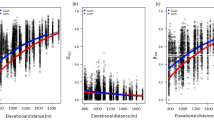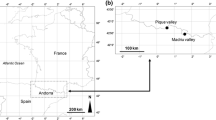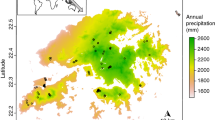Abstract
We explored the ways in which environmental variation at multiple spatial scales influences the organization of ant species into local communities. Ground-dwelling ants were sampled in sandhill habitat at 33 locations throughout northern Florida, USA. Variance partitioning of local, landscape, and regional datasets using partial redundancy analysis indicates that ant community composition is significantly influenced by environmental variability across all scales of analysis. Habitat generalists appear to replace habitat specialists at sites with high proportions of matrix habitat in the surrounding landscape. Conversely, habitat specialists appear to replace habitat generalists at sites with more sandhill habitat in the surrounding landscape and greater amounts of bare ground locally. Local niche differentiation leading to species-sorting, combined with the effects of spatially structured dispersal dynamics at landscape scales, may explain this pattern of community structure. Regional influences on local ant communities were correlated with geographical and environmental gradients at distinct regional scales. Therefore, local ant communities appear to be simultaneously structured by different processes that occur at separate spatial scales: local, landscape, and regional scales defined by spatial extent. Our results illustrate the importance of considering multiscale influences on patterns of organization in ecological communities.



Similar content being viewed by others
References
Agosti D, Majer JD, Alonso LE, Schultz TR (eds) (2000) Ants: standardized methods for measuring and monitoring biodiversity. Smithsonian Institution Press, Washington, DC
Amarasekare P (2003) Competitive coexistence in spatially structured environments: a synthesis. Ecol Lett 6:1109–1122
Bestelmeyer BT, Wiens JA (2001) Local and regional-scale responses of ant diversity to a semiarid biome transition. Ecography 24:381–392
Borcard D, Legendre P (2002) All-scale spatial analysis of ecological data by means of principal coordinates of neighbour matrices. Ecol Modell 153:51–68
Borcard D, Legendre P, Drapeau P (1992) Partialling out the spatial component of ecological variation. Ecology 73:1045–1055
Borcard D, Legendre P, Avois-Jacquet C, Tuomisto H (2004) Dissecting the spatial structure of ecological data at multiple scales. Ecology 85:1826–1832
Brotons L, Monkkonen M, Martin JL (2003) Are fragments islands? Landscape context and density-area relationships in boreal forest birds. Am Nat 162:343–357
Brown JH, Kodric-Brown A (1977) Turnover rates in insular biogeography: effect of immigration on extinction. Ecology 58:445–449
Cadenasso ML, Pickett STA, Weathers KC (2004) Effect of landscape boundaries on the flux of nutrients, detritus, and organisms. In: Polis GA, Power ME, Huxel GR (eds) Food webs at the landscape level. University of Chicago Press, Chicago, pp 154–168
Carroll ML, DiMiceli CM, Sohlberg RA, Townshend JRG (2005) 250 m MODIS normalized difference vegetation index. The Global Land Cover Facility, College Park
Chase JM (1996) Differential competitive interactions and the included niche: an experimental analysis with grasshoppers. Oikos 76:103–112
Chase JM, Leibold MA (2003) Ecological niches. University of Chicago Press, Chicago
Chesson P (2000) General theory of competitive coexistence in spatially-varying environments. Theor Popul Biol 58:211–237
Cook WM, Lane KT, Holt RD (2002) Island theory, matrix effects and species richness patterns in habitat fragments. Ecol Lett 5:619–623
Cottenie K (2005) Integrating environmental and spatial processes in ecological community dynamics. Ecol Lett 8:1175–1182
Cumming GS, Spiesman BJ (2006) Regional problems need integrated solutions: pest management and conservation biology in agroecosystems. Biol Conserv 131:533–543
Curtis JT (1959) The vegetation of Wisconsin: an ordination of plant communities. University of Wisconsin Press, Madison
Debinski DM, Holt RD (2000) A survey and overview of habitat fragmentation experiments. Conserv Biol 14:342–355
Debuse VJ, King J, House APN (2007) Effect of fragmentation, habitat loss and within-patch characteristics on ant assemblages in semi-arid woodlands of eastern Australia. Landsc Ecol 22:731–745
Deyrup M, Cover S (2004) A new species of Odontomachus ant (Hymenoptera : Formicidae) from inland ridges of Florida, with a key to Odontomachus of the United States. Fla Entomol 87:136–144
Deyrup M, Davis L, Cover S (2000) Exotic ants in Florida. Trans Am Entomol Soc 126:293–326
ESRI (1999) ArcView version 3.3. Environmental Systems Research Institute (ESRI), Redlands
Gotelli NJ, Ellison AM (2002) Biogeography at a regional scale: determinants of ant species density in New England bogs and forests. Ecology 83:1604–1609
Graves GR, Rahbek C (2005) Source pool geometry and the assembly of continental avifaunas. Proc Natl Acad Sci USA 102:7871–7876
Hanski I, Gilpin M (1991) Metapopulation dynamics: brief history and conceptual domain. Biol J Linn Soc 42:3–16
Henschel JR, Mahsberg D, Stumpf H (2001) Allochthonous aquatic insects increase predation and decrease herbivory in river shore food webs. Oikos 93:429–438
Hoffmann BD, Andersen AN (2003) Response of ants to disturbance in Australia, with particular reference to functional groups. Austral Ecol 28:444–464
Hölldobler B, Wilson EO (1990) The ants. Harvard University Press, Cambridge
Holt RD (1993) Ecology at the mesoscale: the influence of regional processes on local communities. In: Ricklefs RE, Schluter D (eds) Species diversity in ecological communities. University of Chicago Press, Chicago, pp 77–88
Holt RD (2004) Implications of system openness for local community structure and ecosystem function. In: Polis GA, Power ME, Huxel GR (eds) Food webs at the landscape level. University of Chicago Press, Chicago, pp 96–114
Holt RD, Barfield M (2003) Impacts of temporal variation on apparent competition and coexistence in open ecosystems. Oikos 101:49–58
Holyoak M, Leibold MA, Holt RD (eds) (2005) Metacommunities: spatial dynamics and ecological communities. University of Chicago Press, Chicago
Karlson RH, Cornell HV (1998) Scale-dependent variation in local vs. regional effects on coral species richness. Ecol Monogr 68:259–274
King JR (2007) Patterns of co-occurrence and body size overlap among ants in Florida’s upland ecosytems. Ann Zool Fenn 44:189–201
King JR, Porter SD (2005) Evaluation of sampling methods and species richness estimators for ants in upland ecosystems in Florida. Environ Entomol 34:1566–1578
Kneitel JM, Chase JM (2004) Trade-offs in community ecology: linking spatial scales and species coexistence. Ecol Lett 7:69–80
Legendre P, Gallagher ED (2001) Ecologically meaningful transformations for ordination of species data. Oecologia 129:271–280
Leibold MA, Holyoak M, Mouquet N, Amarasekare P, Chase JM, Hoopes MF, Holt RD, Shurin JB, Law R, Tilman D, Loreau M, Gonzalez A (2004) The metacommunity concept: a framework for multi-scale community ecology. Ecol Lett 7:601–613
Lubertazzi D, Tschinkel WR (2003) Ant community change across a ground vegetation gradient in north Florida’s longleaf pine flatwoods. J Insect Sci 3:1–17
MacArthur RH (1958) Population ecology of some warblers of northeastern coniferous forests. Ecology 39:599–619
MacArthur RH (1972) Geographical ecology. Harper and Row, New York
Marquet PA, Cofre H (1999) Large temporal and spatial scales in the structure of mammalian assemblages in South America: a macroecological approach. Oikos 85:299–309
Marvier M, Kareiva P, Neubert MG (2004) Habitat destruction, fragmentation, and disturbance promote invasion by habitat generalists in a multispecies metapopulation. Risk Anal 24:869–878
Myers RL, Ewel JJ (eds) (1990) Ecosystems of Florida. University of Central Florida Press, Orlando
Noss RF, LaRoe ET III, Scott JM (1995) Endangered ecosystems of the United States: a preliminary assessment of loss and degradation. National Biologic Survey Biological Report 28, Department of the Interior, Washington
Oksanen J, Kindt R, Legendre L, O’Hara B (2006) vegan: Community ecology package. Version 1.8-2. URL http://cc.oulu.fi/~jarioksa/.
Peres-Neto PR, Legendre P, Dray S, Borcard D (2006) Variation partitioning of species data matrices: estimation and comparison of fractions. Ecology 87:2614–2625
Polis GA, Anderson WB, Holt RD (1997) Toward an integration of landscape and food web ecology: the dynamics of spatially subsidized food webs. Annu Rev Ecol Syst 28:289–316
Polis GA, Power ME, Huxel GR (eds) (2004) Food webs at the landscape level. University of Chicago Press, Chicago
Pulliam HR (1988) Sources, sinks, and population regulation. Am Nat 132:652–661
Rand TA, Tylianakis JM, Tscharntke T (2006) Spillover edge effects: the dispersal of agriculturally subsidized insect natural enemies into adjacent natural habitats. Ecol Lett 9:603–614
R Development Core Team (2006) R: a language and environment for statistical computing. R Foundation for Statistical Computing, Vienna, Austria. ISBN 3-900051-07-0, URL http://www.R-project.org
Ricklefs RE (1987) Community diversity: relative roles of local and regional processes. Science 235:167–171
Schoereder JH, Sobrinho TG, Ribas CR, Campos RBF (2004) Colonization and extinction of ant communities in a fragmented landscape. Austral Ecol 29:391–398
Shmida A, Wilson MV (1985) Biological determinants of species diversity. J Biogeogr 12:1–20
Srivastava DS (1999) Using local-regional richness plots to test for species saturation: pitfalls and potentials. J Anim Ecol 68:1–16
Stys B, Kautz R, Reed D, Keller C, Davis A (2004) Florida vegetation and land cover – 2003. Florida Fish and Wildlife Conservation Commission, Tallahassee
Thies C, Steffan-Dewenter I, Tscharntke T (2003) Effects of landscape context on herbivory and parasitism at different spatial scales. Oikos 101:18–25
Tilman D (1982) Resource competition and community structure. Princeton University Press, Princeton
Tschinkel WR (2004) The nest architecture of the Florida harvester ant, Pogonomyrmex badius. J Insect Sci 4:1–19
Urban MC, Skelly DK, Burchsted D, Price W, Lowry S (2006) Stream communities across a rural-urban landscape gradient. Divers Distrib 12:337–350
Van Pelt AF Jr (1958) The ecology of the ants of the Welaka Reserve, Florida (Hymenoptera: Formicidae). Part II annotated list. Am Midl Nat 59:1–57
Whittaker RH (1960) Vegetation of the Siskiyou Mountains, Oregon and California. Ecol Monogr 30:280–338
Wiens JA (1989) Spatial scaling in ecology. Funct Ecol 3:385–397
Acknowledgements
We thank S. Baban, E. Bruna, A. George, R. Holt, B. Inouye, T. Kim, J. King, J. Southworth, T. Crist, and two anonymous reviewers for valuable comments and discussion. We also thank the Florida Division of Forestry, Florida Dept. of Environmental Protection, and the Ordway-Swisher Biological Station for logistical support. S. Iguchi, K. Larson, and J. Vanderberg assisted with field and lab work. Funding was provided by the USDA T-STAR program, and the University of Florida TCD program.
Author information
Authors and Affiliations
Corresponding author
Electronic supplementary material
Rights and permissions
About this article
Cite this article
Spiesman, B.J., Cumming, G.S. Communities in context: the influences of multiscale environmental variation on local ant community structure. Landscape Ecol 23, 313–325 (2008). https://doi.org/10.1007/s10980-007-9186-3
Received:
Accepted:
Published:
Issue Date:
DOI: https://doi.org/10.1007/s10980-007-9186-3




